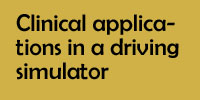Driving phobia or excessive fear of driving refers to people who are so afraid to drive a car, that they avoid to drive a car. These people have obtained their drivers licence at some time. This may impact their lives severely and reduces their mobility. In the Netherlands between 800.000 and 1.000.000 people suffer from some form of fear of driving or driving phobia. Driving in a simulator can help to overcome fear of driving or driving phobia.
Methods and techniques based on Virtual Reality are applied to treat fear effectively, for example hosophobia, fear of spiders, etc., and they have proved to work. The advantage of simulators, and virtual reality in general, consists of the opportunities it provides to practice in a safe environment while the stimuli that evoke the fear response are presented in a controlled way. People are exposed to the fear-inducing stimuli, a technique also referred to as exposure therapy. This is probably the most effective technique from behavioural therapy to treat specific fears, such as driving phobia. Driving in a simulator will initially be frightening for people with fear of driving, but after some time of driving, fear will typically reduce.
The training has to have the following characteristics to be effective:
- Driving in the simulator must be realistic.
- The most frightening situations must be trained, for example driving on a highway with high traffic density.
- People with driving experience and an age above 30 may be susceptible to simulator sickness. The simulations must be made such that the risk of simulator sickness is small.
- The simulations must be long enough. If the session is too short and stops while fear has not been reduced, then the session may be counterproductive.



